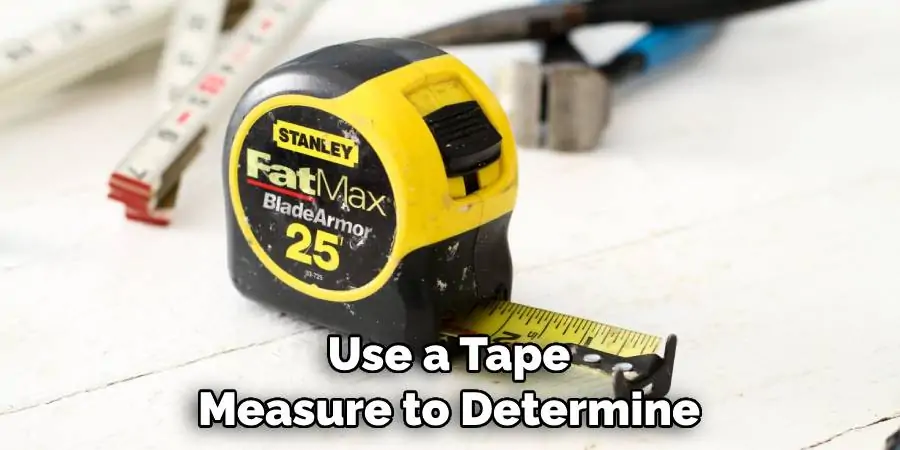Undermount sinks are a modern and stylish addition to any kitchen or bathroom. Unlike traditional top-mount sinks, undermount sinks are mounted underneath the countertop, creating a seamless and clean look. However, the installation process for undermount sinks is slightly different from top-mount sinks, making it important to accurately measure the space before purchasing and installing one. In this guide, we will discuss the steps on how to measure for an undermount sink, ensuring a perfect fit and hassle-free installation.

What Are the Standard Sizes for Undermount Sinks?
Before measuring for your undermount sink, it is important to understand the standard sizes available. The most common widths for undermount sinks are 22 inches, 25 inches, and 30 inches, with a depth of around 9-10 inches. However, there are also custom-sized undermount sinks available that can fit specific countertop dimensions.
It is recommended to measure the space and choose a sink that is 1-2 inches smaller than the cabinet width to ensure enough room for installation.
Tools You Will Need
To accurately measure for your undermount sink, you will need the following tools:
- Tape measure
- Pencil or marker
- Straightedge ruler
- Level
Step-by-Step Guide on How to Measure for an Undermount Sink
Whether you’re updating your kitchen or bathroom, installing a new undermount sink can be a rewarding project that adds both style and functionality to your space. Proper measurements are key to ensure a seamless installation. Here’s a step-by-step guide to measuring for your undermount sink.
Step 1: Survey the Space
Before you get down to taking measurements, it’s important to survey the area. Take a good look at the underside of your countertop and the cabinet where the sink will be installed. Note any existing plumbing, braces, or other structures that may impact the sink’s placement or the reach of your tools.
Step 2: Measure the Cabinet Width
Use a tape measure to determine the width of the space where your sink will be installed. Measure both the top and bottom of the cabinet to ensure there are no irregularities. This will help you choose a sink that fits the space correctly. Be sure to write down the smallest measurement if there is a variance, as this will be the limiting factor for your sink size. Further, it’s critical to check that the cabinet material can support the weight and installation of an undermount sink, as this style typically requires additional support from below.

Step 3: Check for Depth
With the tape measure, gauge the depth of the cabinet from the underside of the counter to the floor. Depth will come into play when selecting the sink for installation. You need to make sure there’s sufficient room for the tailpiece, the waste trap, and for any additional plumbing fixtures that will be below the sink. Remember to leave enough clearance for installation and future maintenance activities. Record this measurement carefully, as it will determine the maximum depth of sink that your space can accommodate without requiring plumbing adjustments.
Step 3: Consider Drain Placement
The location of the drain in an undermount sink is crucial. Measure the distance from the back wall of the cabinet to the center of the existing drain. This measurement is pivotal as it will determine which sink models are compatible with your current plumbing setup.
Sinks with drains located towards the rear of the basin tend to increase the available space under the sink, providing better storage options. Ensure to jot down these measurements and keep them handy when you’re shopping for your new sink. Choose a model with a drain placement that aligns with these measurements to prevent the need for significant plumbing changes.
Step 4: Sink’s Basin Size
Take precise measurements of the sink’s basin—both the length and width. This will help you understand how much counter space your new sink will occupy. A larger basin may offer more functionality, but you’ll need a larger cutout in your countertop for installation. It’s essential to balance the size of the sink with the available workspace on the countertop.
In kitchens with limited counter space, a massive sink could constrain your work area. Conversely, if ample room is available, a bigger basin can accommodate larger pots and pans, making kitchen tasks more manageable. Always consider the proportion of the sink to your total counter space to maintain a functional and aesthetically pleasing kitchen environment.

Step 5: Measure for the Cut-Out
To house your undermount sink, you’ll need to create a cut-out in the countertop. Use the basin measurements and add the required overhang (typically around 1 to 1 ½ inches) to calculate the size of the cut-out. Double-check these measurements as they are critical to a good fit.
Step 6: Countertop Overhang
How much overhang do you want? The standard is 1 to 1 ½ inches, but personal preference and the amount of space you have will influence this choice. Verify this is compatible with your space as other side fixtures and outlets may require a larger or smaller overhang. It’s crucial to take into account any nearby features that might be affected by the overhang, ensuring there’s ample space for doors to open, room to install fixtures, and access to outlets. Always leave a comfortable clearance to avoid a cramped kitchen layout.
Step 7: Mark the Cut-Out
Once you have your measurements, apply painter’s tape to the countertop to mark the boundaries of your cut-out. The tape not only helps in visualizing the location but also protects the countertop from scratches and provides a clear line to follow during cutting. If you’re more comfortable with a marker, outline the cut-out directly on the surface. This visual guide will ensure precision when it’s time to cut, helping to avoid costly mistakes.
Step 2: Double-Check and Re-measure
After marking the cut-out, re-measure the area and check it against the sink’s specifications. Ensure you have measured accurately and that your cut-out will fit the sink with the determined overhang. Precision at this stage will save you headaches later. It’s worth taking the time to measure twice, cutting once to ensure a seamless installation process. Ensure that you account for any potential irregularities in wall angles or cabinet placement that could affect the cut-out dimensions. Remember, a precise cut-out is crucial for a stable and secure sink installation.
Step 10: Adjusting for Clips
Some undermount sinks come with clips to secure them to the countertop. If this is the case, ensure you have accounted for the additional space required. Adjust your cut-out size if necessary, keeping in mind that some clips may push the sink out by up to an inch.
By carefully following these steps, you’ll be fully equipped to complete the next phases of your undermount sink installation with confidence. Once your sink is in place, you can look forward to enjoying both the practical advantages and the aesthetic upgrade it brings to your space.

Frequently Asked Questions
How Much Space Do You Need Around an Undermount Sink?
When considering the installation of an undermount sink, the question of space is not just practical but essential. How to measure for an undermount sink is a valuable skill that can save you from the pitfalls of cramped kitchen designs. Firstly, ensure that there’s adequate clearance between the edges of the sink and the interior cabinet walls – typically at least 0.5 inches to allow for secure mounting and easy access.
Beyond this, consider the surrounding workspace: do you have enough room for food preparation, dish drying, and necessary accessories? A well-spaced sink design can be the difference between a kitchen that’s merely serviceable and one that’s a joy to use. So, take time to measure meticulously, contemplate your workflow, and your kitchen will not just function flawlessly but also evoke the charm and efficiency of professional culinary spaces.
Can I Install an Undermount Sink Myself?
While it is possible to install an undermount sink yourself, it is not recommended unless you have experience with similar DIY projects. The process can be complex and requires precise measurements and cutting techniques. It is best to consult a professional for installation if you are unsure of your abilities.

How Do I Choose an Undermount Sink?
When choosing an undermount sink, consider the size and shape that will best fit your space, as well as the material and finish. Additionally, make sure to check for compatibility with your countertop material and installation requirements. It may also be helpful to read reviews or consult with a professional for recommendations.
Conclusion
In this guide, we have discussed about how to measure for an undermount sink and provided tips for ensuring a successful installation process. Remember to measure carefully, consider your kitchen’s workflow, and consult a professional if needed. With proper planning and execution, an undermount sink can elevate the functionality and aesthetic appeal of your kitchen.
So, whether you are replacing an old sink or embarking on a kitchen renovation, consider an undermount sink for a sleek and sophisticated look that also maximizes countertop space. With its seamless integration and easy maintenance, it is no wonder why undermount sinks have become a popular choice among homeowners. So take the time to carefully choose your undermount sink and enjoy all the benefits it has to offer for years to come.
